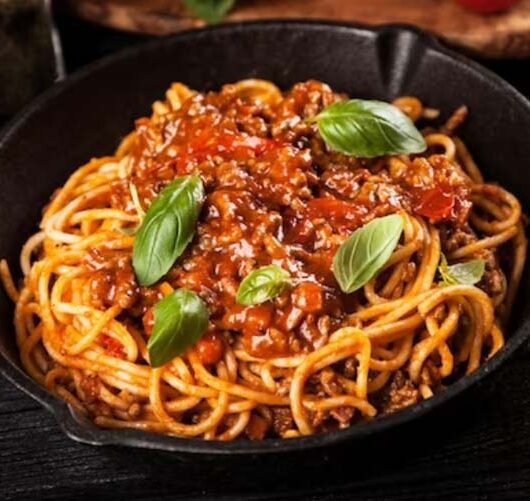Bolognese pasta is a classic dish of Italian cuisine that consists of a rich and flavorful sauce made from ground beef, onion, carrots, celery, crushed tomatoes, and spices. The sauce is simmered to allow the flavors to blend and intensify. It is traditionally served over pasta, such as spaghetti or tagliatelle, and finished with grated Parmesan cheese on top. This recipe balances the softness of the ground beef with the sweetness of the vegetables and the acidity of the tomatoes, creating a satisfying and comforting dish. It is a popular choice to enjoy at family gatherings or casual dinners, and its delicious flavor and texture make it a favorite of many lovers of Italian cuisine.

Bolognese pasta and health benefits
Bolognese pasta may offer some health benefits due to the ingredients used in its preparation. Here are some possible benefits:
- Proteins and amino acids: The meat used in bolognese sauce is a source of proteins, which are essential for building and repairing tissues in the body. Proteins are also necessary for the formation of enzymes, hormones and antibodies.
- Vitamins and minerals: Bolognese sauce can provide a variety of vitamins and minerals, depending on the ingredients used. Tomatoes, for example, are a good source of vitamin C and vitamin A, while meat may contain minerals such as iron and zinc.
- Antioxidants: The tomatoes used in bolognese sauce are rich in antioxidants, such as lycopene. Antioxidants help protect cells from damage caused by free radicals and may have beneficial health effects, including reducing the risk of chronic diseases.
- Dietary fiber: Served with whole wheat pasta, bolognese sauce can be a good source of dietary fiber. Fiber is important for digestive health, blood sugar regulation, and feeling full.
- Dietary fiber: Served with whole wheat pasta, bolognese sauce can be a good source of dietary fiber. Fiber is important for digestive health, blood sugar regulation, and feeling full.
It is important to note that the quantity and quality of ingredients, as well as portions and overall balance of the diet, are key factors in obtaining health benefits. Remember that Bolognese pasta should be consumed in moderation as part of a balanced diet and healthy lifestyle.
History of Bolognese Pasta
Pasta Bolognese, known in Italian as “ragù alla bolognese,” is an iconic dish of Italian cuisine that has become popular around the world. Its history dates back to the Emilia-Romagna region, in northern Italy, specifically to the city of Bologna, from which it takes its name.
The original recipe for bolognese sauce is quite old and has evolved over time. Although there are records of minced meat and sauce dishes in the region since the Middle Ages, the modern version of Bolognese sauce took hold in the 19th century.
The original Bolognese sauce recipe is a slow and laborious preparation that uses simple but tasty ingredients. Traditionally, the sauce is made with minced beef, pancetta or bacon, onion, carrot, celery, tomato, red wine, meat broth and milk. The ingredients are simmered for hours to allow the flavors to blend and the sauce to reduce to a thick, rich consistency.
Bolognese sauce is traditionally served with tagliatelle, a wide, flat fresh pasta, although it is also common to serve it with spaghetti or other forms of long pasta. It is usually sprinkled with grated Parmesan cheese before serving.
The popularity of bolognese sauce has spread beyond Italy, and today it is a highly prized dish around the world. However, it is important to note that the original recipe for bolognese sauce is quite different from many of the versions found outside of Italy, especially when it comes to the ingredients and method of preparation. The authentic and traditional version of Bolognese sauce is one of Italy's culinary treasures and remains a delight for food lovers.
Maybe you might like: Classic apple pie
Image credit: freepik



